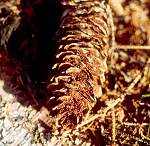
Catinella is a genus of fungi in the class Dothideomycetes. It is placed in the monotypic family of Catinellaceae in the monotypic order of Catinellales.
Mycocitrus is a genus of fungi in the family Bionectriaceae.

Pucciniastrum is a genus of Basidiomycota fungi. Pucciniastrum species, like all rust fungi, are obligate plant parasites.
Phaeodothis is a genus of fungi in the family Didymosphaeriaceae.
Actinopeltis is a genus of fungi in the Trichothyriaceae family.
Palawania is a genus of fungi in the Parmulariaceae family.
Cirsosia is a genus of fungi in the Asterinaceae family. The relationship of this taxon to other taxa within the class is unknown, and it has not yet been placed with certainty into any order.
Peloronectria is a genus of fungi in the Hypocreales order. The relationship of this taxon to other taxa within the order is unknown, and it has not yet been placed with certainty into any family. Unchanged in 2020.
Peter Nielsen was a Danish botanist and plant pathologist.
Hans Sydow was a German mycologist and the son of mycologist and lichenologist, Paul Sydow (1851–1925).

Puccinia sessilis is a fungal species and plant pathogen, which is also known as arum rust or ramsons rust. It commonly infects Arum maculatum and Allium ursinum causing yellow to orange circular patches on leaves. On the underside of the leaves, it produces raised orange aecia commonly covered in spores. It is common in Eurasia in the spring.

Aecidium is a genus of rust fungi in the order Pucciniales.

Chrysomyxa is a genus of rust fungi in the family Coleosporiaceae. The genus, widespread in the Northern Hemisphere, contains about 23 species. Rust fungi in the genus Chrysomyxa occur in boreal forests of the northern hemisphere on Pinaceae,, and most species alternate to angiosperm hosts in the Ericaceae.

Ustilaginoidea is a genus of fungi in the family Clavicipitaceae. The genus contains 19 species. Ustilaginoidea was circumscribed by German botanist Julius Oscar Brefeld in 1895, with Ustilaginoidea oryzae assigned as the type species. Ustilaginoidea virens causes the disesase known alternatively as rice false smut, pseudosmut, or green smut.
Aecidium amaryllidis is a species of fungus in the Pucciniales order. It was described by Syd., P. Syd and E.J.Butler in 1912.
Aecidium aechmantherae is a species of fungus in the Pucciniales order. It was described by Syd. and P. Syd in 1907.
Distocercospora is a genus of plant-pathogenic fungi in the family Mycosphaerellaceae. The genus was circumscribed in 1988 with Distocercospora pachyderma as the type species in 1988.

Asperisporium is a genus of ascomycete fungi whose members are plant pathogens.






